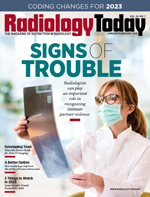 Molecular Imaging News: A Little Help
Molecular Imaging News: A Little Help
By Claudia Stahl
Radiology Today
Vol. 24 No. 1 P. 6
Advanced PET/CT Machine Reduces Scan Time in Pediatric Patients
Professionals who work with radiation for diagnostic and treatment purposes live by the ALARA principle. Producing quality images in faster scan times and with lower doses of radiopharmaceuticals is becoming the benchmark for imaging equipment. ALARA is especially important when imaging children due to the risk of radiation damage to developing cells and tissues.
In the two years since Cincinnati Children’s Hospital Medical Center (CCHMC) acquired one of the most advanced PET/CT systems on the market, the radiology team has reduced the average scan time for patients by 33%. For example, the average scan time for a 3-year-old patient, which was once nine minutes, is now three to four minutes. According to Andrew T. Trout, MD, the director of clinical research for CCHMC’s department of radiology, the shorter scans reduce or, in some cases, eliminate the need for anesthesia in younger patients who previously required sedation to remain still during imaging, removing another procedure-associated risk.
The scanner, GE Healthcare’s Discovery MI Gen 2, uses a combination of digital
detector technology and advanced image reconstruction to maximize scanner sensitivity and produce highly detailed images. The system features a head-to-foot field of view (FOV) scalable from 15 cm to 30 cm, and a sensitivity of 30 counts per second/kilobecquerels, allowing for the detection of lesions as small as 28 mm in less time and at lower radiation doses.
In addition to increased sensitivity, Trout says the scanner’s longer head to- foot FOV enables the team to image more of the patient at once, further speeding up scanning. “Previously, scanning an average-size patient about five feet tall would take a total of 15 bed positions at 90 seconds each, for a total scan time of about 22 minutes. After the in-field upgrade taking [the FOV] up to 30 cm, we can scan that same patient in 19 1/2 minutes.”
Improved Workflow and Clarity
The Discovery MI Gen 2 features multiple complementary technologies that improve workflow and enhance image quality. For example, technologists can landmark and make changes to the position of the scanner table, activities that commonly occur in the imaging suite, from a console in the control room. This saves time and reduces the technologist’s exposure to radiation.
Another feature, MotionFree, automatically tracks patients’ respiratory movement throughout the scan. Left unaddressed, this motion can make PET/CT images unusable or blur or obscure small lesions. Technologists typically use an external gating device to correct this movement in the final images, but the cumbersome setup process adds as many as 11 minutes to the total procedure. The inconvenience discourages teams from using gating equipment unless they believe it’s essential, which can result in missed diagnostic opportunities.
The Discovery MI Gen 2 uses an internal, data-driven gating process to automatically modify images in real time, eliminating the need for external equipment. Technologists have the ability to choose which bed positions receive motion correction, but the system continues to collect respiratory motion data in the background, guaranteeing image correction, in retrospect, if it’s needed.
On the CT side, the system uses AI to build on existing low-dose, iterative reconstruction technology.
Expanded Diagnostic Capabilities
Most of the patients who receive PET/CT imaging at CCHMC have a cancer diagnosis, such as lymphoma or sarcoma (bone- or soft-tissue tumors). Trout says the lower radiation doses that are possible with the newest generation of digital PET scanners are especially beneficial in minimizing the side effects of radiation exposure in treatable cancers such as Hodgkin lymphoma. Digital PET technology also “allows us … to start thinking about using [PET] for patients who don’t have cancer, who have inflammatory disorders or other situations where, in the past, we would have avoided using it because of concerns around radiation exposure,” he adds.
Shifts in clinical guidelines now support the use of PET for conditions such as fever of unknown origin or osteomyelitis, but Trout’s research will continue to focus on cancer patients. “We’re dialing in on exactly how low we can go (in scan time and dose), to maximize benefit to our patients while ensuring we have evidence to back up those decisions,” he says. CCHMC and the biomedical engineering department at the University of Cincinnati are also collaborating to develop additional approaches using deep learning and AI “to help us improve the lower-quality images that we’re going to get with lower doses,” he adds.
New radiopharmaceuticals widen the diagnostic potential of PET/CT, making it possible for facilities to evaluate more conditions without adding or upgrading equipment. Along with other medical research centers, CCHMC is participating in a clinical trial of a radiopharmaceutical that could make PET an imaging option for neuroblastoma.
“For the longest time, we were only able to image neuroblastoma with gamma cameras, which have less sensitivity and require 45- to 90-minute exam times,” Trout explains. “With its greater imaging capability, PET brings the exam time down to 15 minutes or less.”
Collectively, these advances in technology are expected to continue to lower procedural risks while expanding disease detection. Trout says CCHMC’s new PET/CT has already “allowed us to make a substantial leap in terms of how we’re imaging and taking care of our cancer patients, and we’re only looking forward.”
— Claudia Stahl is a freelance writer based in Ambler, Pennsylvania. She specializes in writing about the health of people and the planet.
